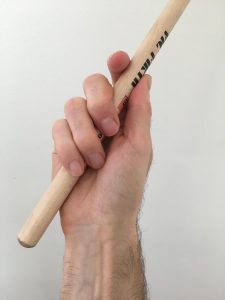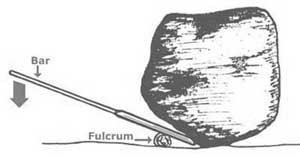Here’s a challenging drumming independence exercise that also sounds musical. It’s a sixteenth note paradiddle between the snare and kick drum where the right hand is replaced by the kick drum – KLKKLKLL – That frees the right hand–which is playing every third sixteenth note on the cymbal stack. The icing on the cake is adding eighth notes with the hi-hat pedal. However, since the pattern is rather busy I decided not to include the hi-hat foot in the notation.
Category Archives: Drum Lessons
Drumstick Grip Palm Placement – German Grip
When using german grip, some of my drum students have asked, “where should their drumsticks be placed in relation to their palms?”
There are a few different schools of thought here. One setup is that the stick should be placed directly down the middle of the palm (fig 1). Using this placement helps the stick feel like an extension of your hands and enables contact with the meaty part of the finger tips on the stick, which is beneficial.
However, one potential problem with this placement is that with most hands the pinky will lose contact with the stick. I have average size hands and fingers; as you can see (fig.1) my pinky is not able to easily connect with the stick. Another drawback is that due to the alignment of the butt-end of the stick, you can’t easily use this placement for any Moeller-esque strokes.
In fig. 2 the base of the stick is placed on the lateral aspect of the palm. This placement provides connectivity for all fingers regardless of the size of the hands. This placement creates a solid foundational drumming grip that can easily be utilized for Moeller-type playing.
This is also the placement that Sanford (Gus) Moeller talks about in his seminal Moeller Book. Moeller’s recommended right hand grip (Fig. 3) placed the fulcrum with the fourth finger. This enabled the snare drum players of his time to play downstrokes with more leverage while remaining relaxed. While we don’t see too many players utilizing it today, it could be considered as a training technique to build up strength in the back fingers.
Another popular setup is to place the drum stick over the outside edge of the wrist bone known as the pisiform (fig. 4). This placement is illustrated in “Practical Method of Developing Finger Control” by Roy Burns and Lewis Malin. This placement gives you the best of both worlds as it’s a good choice for Moeller strokes and it also gives you optimal finger control especially with the fourth and fifth fingers.
How to Hold Drum Sticks for Beginners (Video)
In terms of holding the sticks, there are a few different grip points to consider. The Moeller book teaches it from the back fingers (little finger grip). Murray Spivack’s technique teaches the fulcrum between the thumb and middle finder. For most beginners I find that the easiest fulcrum to teach and learn is between the thumb and the index finger.
So what is this thing we drummers call “fulcrum.” For starters, it’s a term that has gained enough attention to warrant a wikipedia entry. Basically, the fulcrum is the support which enables a lever to pivot. It’s an engineering term that has been adapted by drummers to notate the area of the grip that acts as a hinge to enable the sticks to pivot. Although a fulcrum can exists on different part of the stick, each stick has an optimal area that yields the most rebound for each stroke. I go into more detail on that optimal balance point in the video below as well as a few other details I like to point out when teaching beginners how to hold their drumsticks.
Paradiddle Accents
If you are looking for ways to change up the paradiddle accents then check out this video. It implies you have a good understanding of how to play the paradiddle with the Moeller technique. If you need a refresher, you can check out the Paradiddle speed builder lesson.





